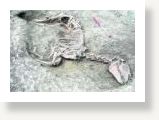
© UnknownThe horse skeleton found by the archaeologists.
Remains dating back thousands of years have been uncovered on the site of Didcot's Great Western Park housing development.
Archaeologists have uncovered a host of fascinating artefacts during a dig on the site as work begins on the 3,300-home development.
Builders Taylor Wimpey said "significant historical findings" have been made at the site, west of the town, over the past month by staff from Oxford Archaeology.
The oldest artefacts are a Neolithic flint arrowhead, used by early hunters, and a bowl thought to be for ceremonial purposes.
Ten roundhouses have been discovered, thought to be part of a late Bronze Age and Iron Age hillcrest settlement at the site,.
They were identified by a ring of post-holes and timber-framed structures, which are believed to have supported a thatched roof.
Similar square structures have also been found, thought to have been used to store food.
Other finds include remains of a Roman villa and farmstead and a medieval horse burial. It appears that the animal was put down because of a broken leg.
Taylor Wimpey commissioned the dig to chart the area's history and preserve as much as possible for posterity.
Chris Ashmore, marketing director for Taylor Wimpey in Oxfordshire, said: "We're eager to safeguard this window to the past - much of the Roman farmstead, for instance, will be preserved under sports pitches.
"Our intention is for the development to provide homes for generations to come in Didcot, just as the site has done for thousands of years."
The archaeological work will continue alongside building work and once Great Western Park is completed, a full report will be published.
The first phase of the estate, with 220 homes, will be ready in the summer.
Didcot and District Archaeological and Historical Society spokesman Joyce Hall said: "These are fascinating finds. A lot of our members are quite old now and I hope these discoveries will give our society a new lease of life.
"Until the railway arrived in Didcot in the 1800s, it was just a small village but people have been living in the area for thousands of years."
She said she had found fragments from a Roman period pot near All Saints' Church in the 1970s.

Reader Comments
to our Newsletter